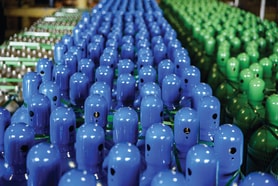Gases in the fast lane
Michael Schumacher, Fernando Alonso, Kimi Raikkonen and perhaps one day, Lewis Hamilton – Formula One (F1) World Champions who take speed and racing to the maximum in pursuit of motorsport glory.
Drivers who push themselves, their teams, and ultimately their finely tuned, multi-million dollar race cars to the limit. Drivers who are ‘cooking on gas’ all around the world as they race on what are often nitrogen-filled tyres.
When thinking of motorsport it’s easy to conjure thoughts of the sheer speed, attractive aerodynamics, lightweight composite construction, and high octane engines. Yet behind the technical masterpiece that is the modern F1 car, the application of industrial gases is arguably in pole position as a race car’s single biggest performance variable.
Burning rubber
The typical tyre of an F1 car, as also applicable throughout many formats of motorsport, is produced to be as lightweight and strong as possible and last for an average distance of around 200km. This could involve anything from one tonne of downforce, 4g of lateral load and 5g of longitudinal load constantly being inflicted upon the tyre throughout its racing life.
... to continue reading you must be subscribed










